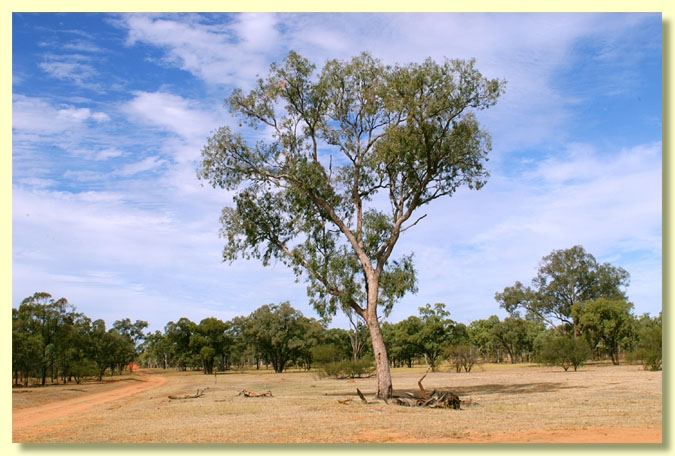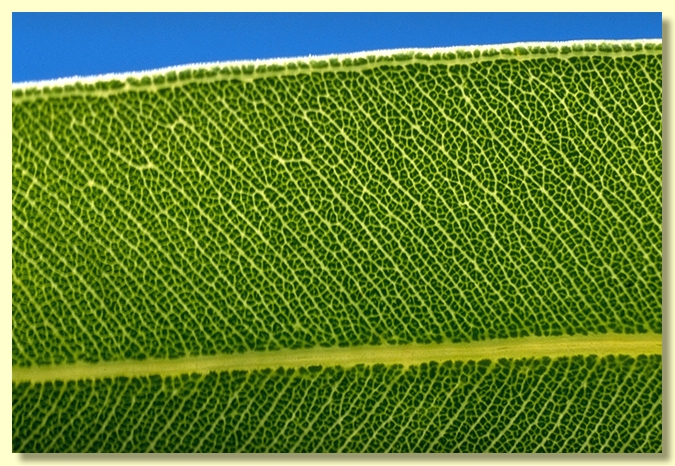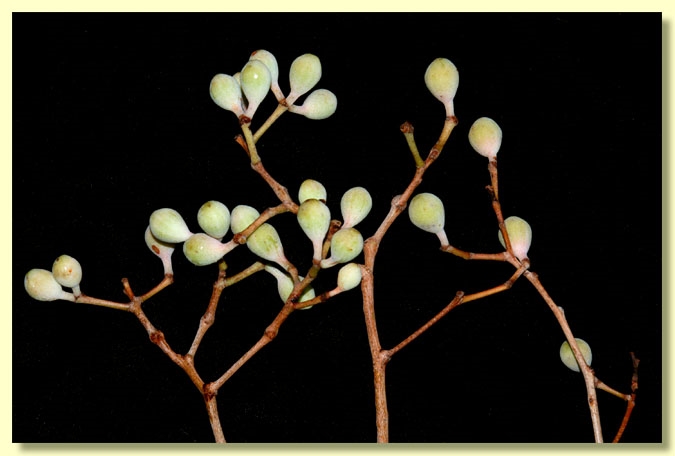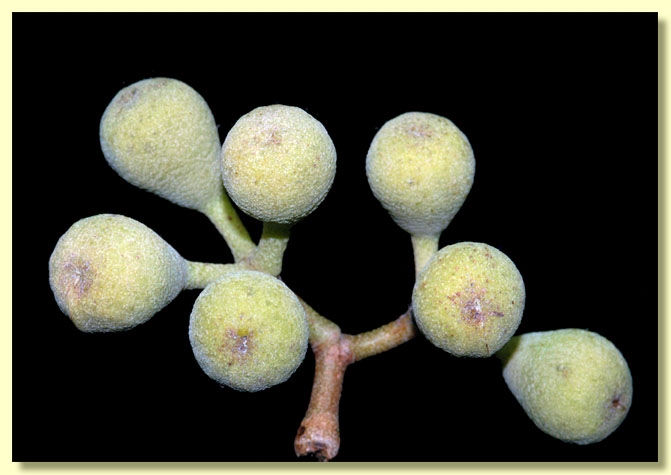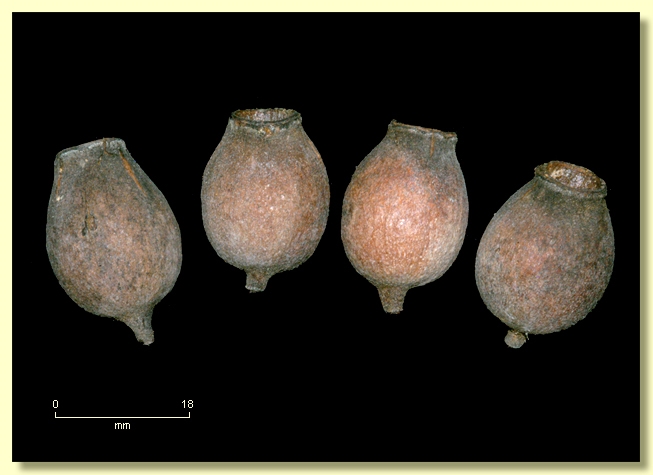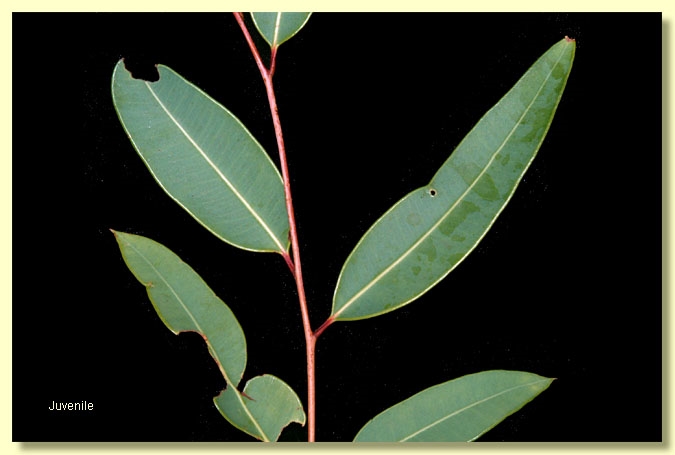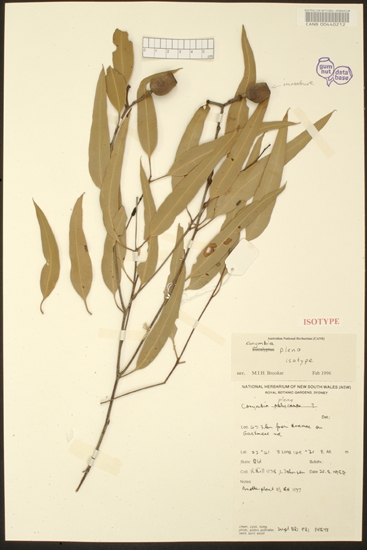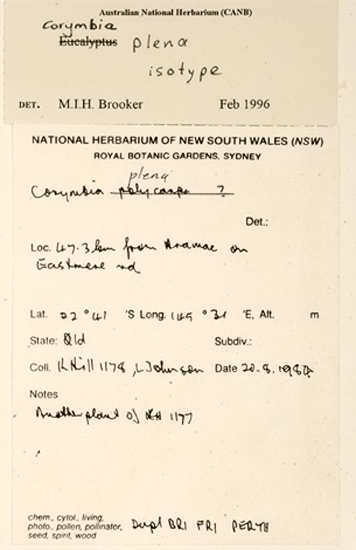Corymbia | Rufaria
Euclid - Online edition
Corymbia plena
Corymbia plena K.D.Hill & L.A.S.Johnson, Telopea 6: 268 (1995).
Tree to 15 m tall. Forming a lignotuber.
Bark rough over trunk and branches extending to small limbs, tight, thick, chunky, tessellated, grey-brown over light red-brown.
Branchlets smooth (glabrous); lacking elongated oil glands in the pith.
Juvenile growth (coppice or field seedlings to 50 cm): stems rounded in cross-section, glabrous; leaves always petiolate, opposite only at lower nodes then alternate, elliptical to lanceolate, 6.5–10.5 cm long, 2.3–3 cm wide, base tapering to petiole, apex rounded or pointed, dull, green, glabrous.
Crown dark green.
Adult leaves alternate, petioles 0.7–2.3 cm long; blade lanceolate to falcate, 7.6–15.5(18) cm long, 1–2.5(3) cm wide, base tapering to petiole, margin entire, apex pointed, discolorous, glossy to slightly glossy or dull, dark green, smooth, side-veins greater than 45° to midrib, reticulation dense to very dense, intramarginal vein present, oil glands usually visible, island, one per areole or obscure sometimes.
Inflorescence terminal compound, peduncles 0.7–2.3 cm long; buds 7 per umbel, usually pedicellate (pedicels 0–1.4 cm). Mature buds obovoid to pyriform or sub-globular, 1.1–1.7 cm long, 0.7–1.2 cm wide, surface greyish scurfy due to fragmenting rubber cuticle, scar absent (both opercula shed together at flowering), operculum shallowly rounded to conical, umbonate or not, stamens inflexed, all fertile, anthers oblong, dorsifixed, versatile, dehiscing by longitudinal slits, style long and straight, stigma blunt with some obvious long papillae around edge, locules 4, the placentae each with ca 7 ± indistinct ovule rows. Flowers creamy white.
Fruit usually pedicellate (pedicels 0–1 cm long), ± urn-shaped to barrel-shaped, often much longer than wide, slightly contracted to form a neck with the thick rim slightly flared or the neck lacking and the rim not flared, length 2–3.1 cm, 1.3–2 cm wide, ± smooth, disc descending vertically, valves 4, enclosed.
Seeds brown, 9–12 mm long, ellipsoidal with terminal wing, hilum ventral.
Cultivated seedlings (measured at ca node 10): cotyledons reniform; stems rounded in cross-section, sparsely setose with short bristle-glands for only ca 2–5 nodes then glabrous; leaves always shortly petiolate, opposite for at least 10 nodes, lowest leaves elliptical becoming narrowly oblong-lanceolate, 6.5–8 cm long, 1.4–1.6 cm wide, base tapering to petiole, discolorous, ± glossy, green, only sparsely setose on lower leaves, glabrous after ca 3 pairs.
Flowering has been recorded in May and June.
Stately bloodwood tree endemic to central Queensland from the White Mountains between Hughenden and Balfes Creek near Charters Towers, extending south to the Alpha – Lochnagar – Mantuan Downs area east and south-east of Barcaldine. It occurs on deep yellow or red sandy soils often along creek lines. Corymbia plena is fully rough-barked, has a dark green crown of leaves that are paler on the underside, large sub-globular scurfy buds to ca 1.5 cm long and 0.9 cm wide and thick-walled urn-shaped to barrel-shaped fruit that are longer than wide (to 3.1 cm by 2 cm). Juvenile leaves are elliptic-lanceolate, dull green and glabrous.
C. plena is one of a group of species characterised by scurfy buds, discolorous leaves and rough bark extending to the small branches. Within this group C. polycarpa and C. novoguinensis have a more northerly, monsoonal distribution whilst the widespread C. clarksoniana differs in having smaller buds and smaller urn-shaped fruit with a thin rim, and setose juvenile leaves; and C. ligans has slightly smaller thin-rimmed fruit and narrower crown leaves (but with some overlap in dimensions).
Within the natural range of C. plena the following more distantly related rough-barked bloodwoods with discolorous adult leaves might be confusing: C. lamprophylla differs from C. plena in having smooth buds and very glossy adult leaves; C. hendersonii has smooth not scurfy, buds, but is similar to C. plena in the thick rimmed fruit and glabrous juvenile leaves; C. brachycarpa and C. clandestina both differ from C. plena in having smaller smooth buds, smaller thin-rimmed urceolate fruit and narrow-leaved juveniles. The widespread C. terminalis has similar scurfy buds to C. plena but has concolorous leaves.
MORE ABOUT CORYMBIA
MORE ABOUT RED BLOODWOODS
Eucalyptus plena: Latin plenus, full or stout, referring to the large thick-walled fruit.

